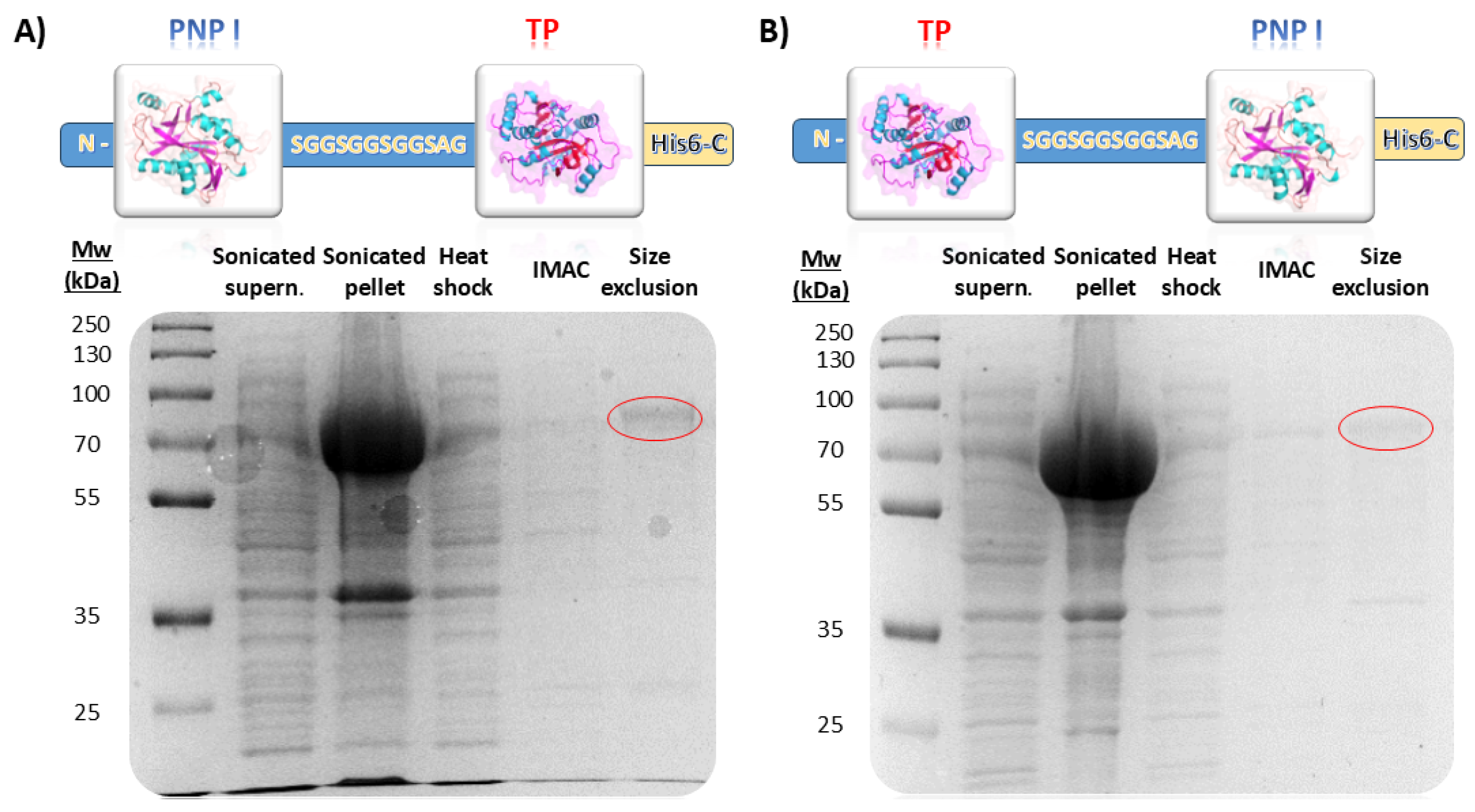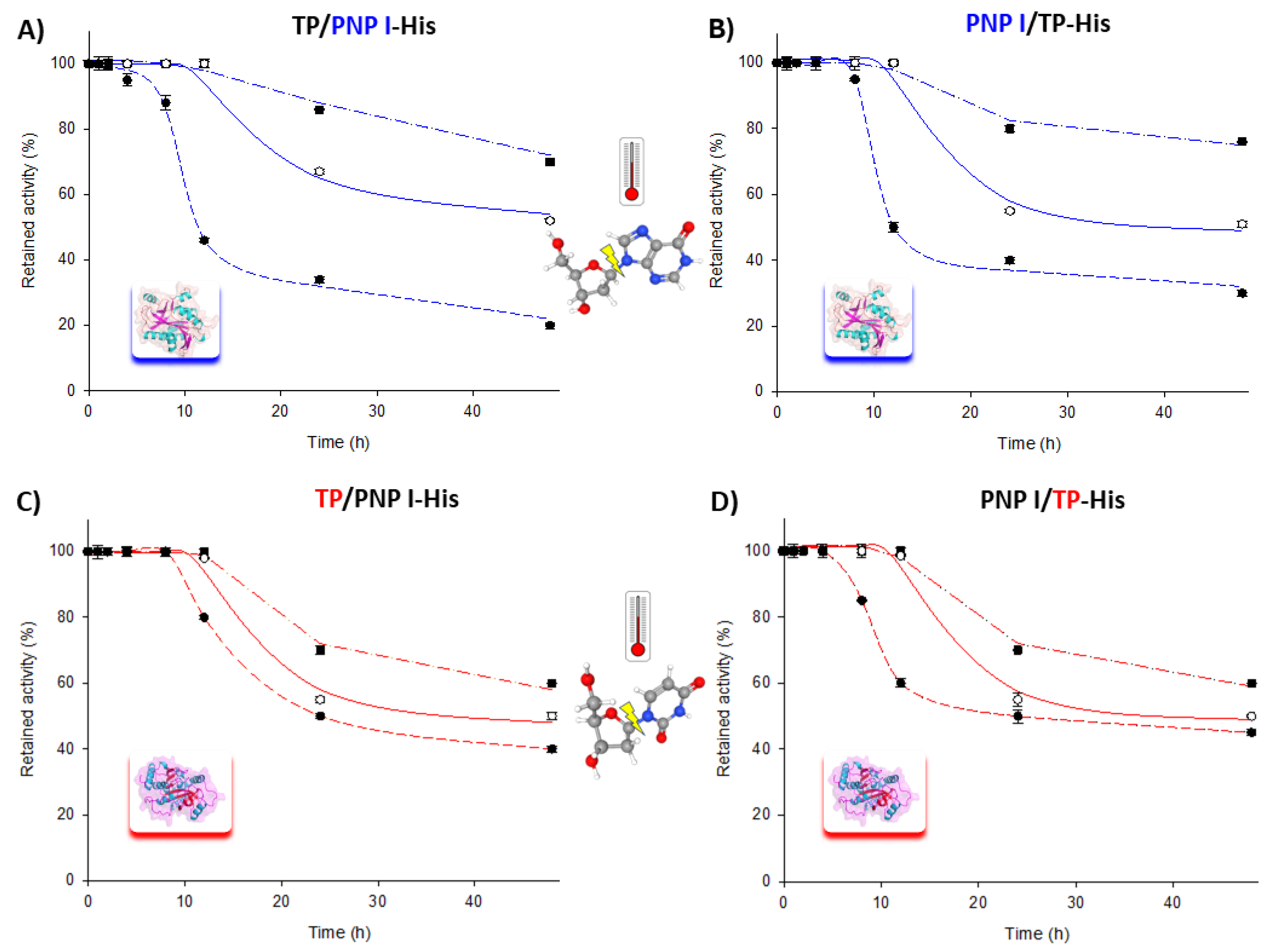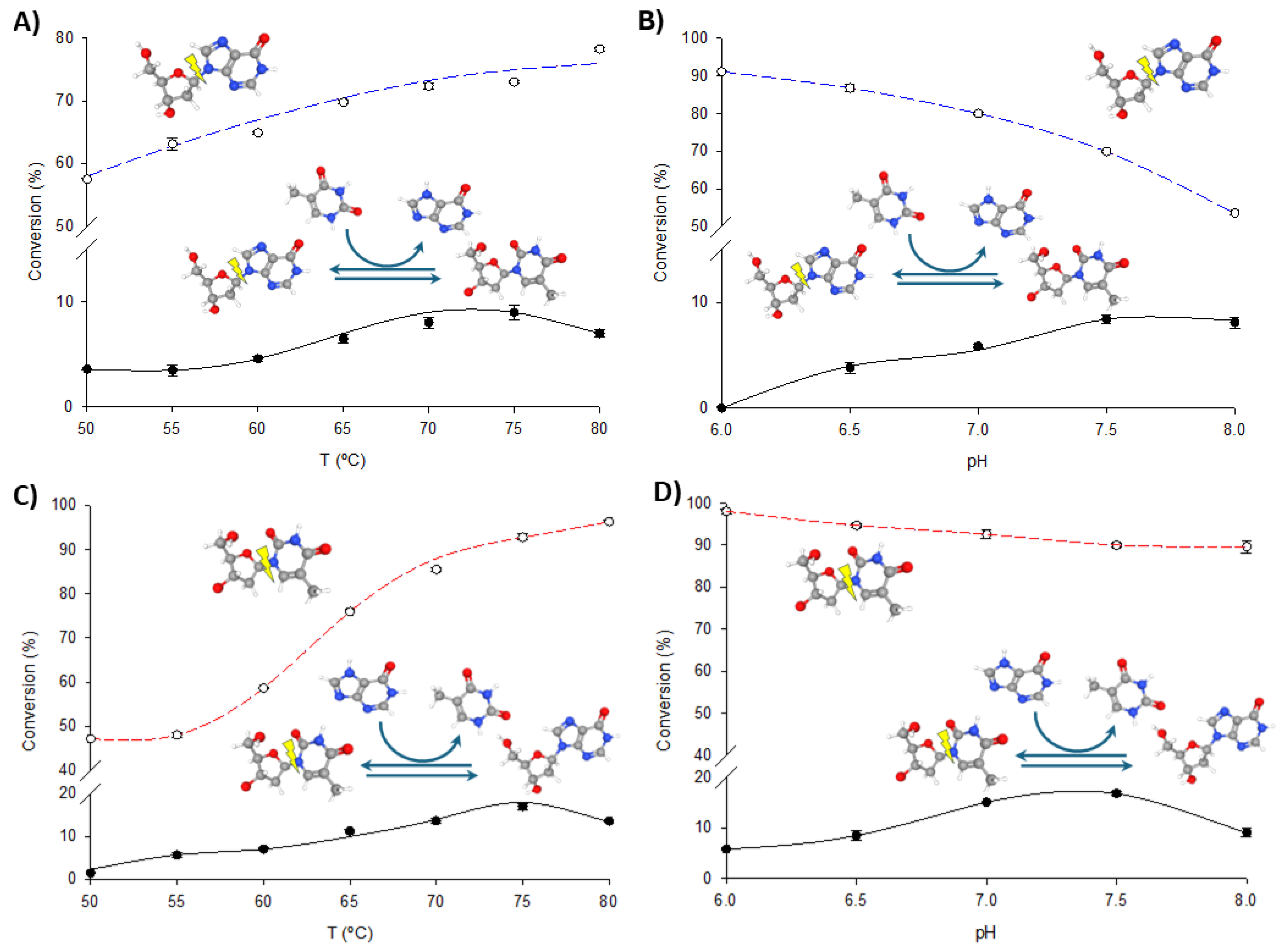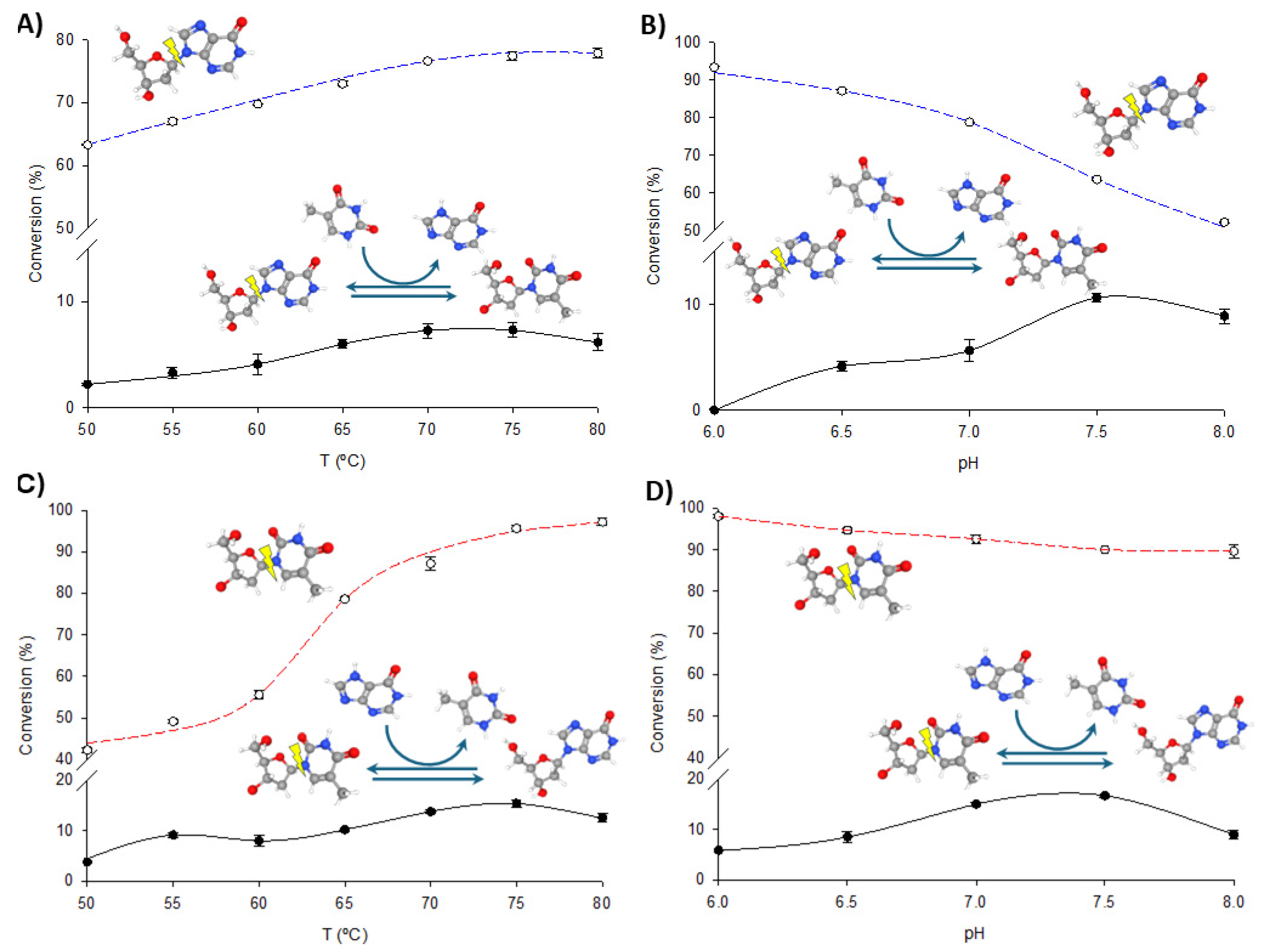Engineering a Bifunctional Fusion Purine/Pyrimidine Nucleoside Phosphorylase for the Production of Nucleoside Analogs
Abstract
:1. Introduction
2. Materials and Methods
2.1. Materials
2.2. Molecular Cloning
2.3. Enzyme Production and Purification
2.4. Standard Assay for Enzyme-Mediated Phosphorolysis of Nucleosides
2.5. Biochemical Characterization
2.6. Standard Assay for Transglycosylation Activity
2.7. Influence of pH and Temperature on Transglycosylation Capability of TP/PNP I-His and PNP I/TP-His
2.8. Enzymatic Synthesis of Nucleoside Analogs
2.9. Analytical Methods
3. Results and Discussion
3.1. Engineering, Production, and Purification of Bifunctional Fusion Enzymes
3.2. Biochemical Characterization of the Phosphorolytic Activity in the Fusion Enzymes
3.3. Biochemical Characterization of the Transglycosylation Capability of PNP I/TP-His and TP/PNP I-His Fusion Enzymes
3.4. Enzymatic Synthesis of Nucleoside Analogs Using PNP I/TP-His and TP/PNP I-His Fusion Enzymes
4. Conclusions
Supplementary Materials
Author Contributions
Funding
Institutional Review Board Statement
Informed Consent Statement
Data Availability Statement
Conflicts of Interest
References
- Lapponi, M.J.; Rivero, C.W.; Zinni, M.A.; Britos, C.N.; Trelles, J.A. New developments in nucleoside analogues biosynthesis: A review. J. Mol. Catal. B Enzym. 2016, 133, 218–233. [Google Scholar] [CrossRef]
- Del Arco, J.; Fernández-Lucas, J. Purine and pyrimidine salvage pathway in thermophiles: A valuable source of biocatalysts for the industrial production of nucleic acid derivatives. Appl. Microbiol. Biotechnol. 2018, 102, 7805–7820. [Google Scholar] [CrossRef] [PubMed]
- Del Arco, J.D.; Fernandez-Lucas, J. Purine and pyrimidine phosphoribosyltransferases: A versatile tool for enzymatic synthesis of nucleoside-5’-monophosphates. Curr. Pharm. Des. 2017, 23, 6898–6912. [Google Scholar] [CrossRef]
- Iglesias, L.E.; Lewkowicz, E.S.; Medici, R.; Bianchi, P.; Iribarren, A.M. Biocatalytic approaches applied to the synthesis of nucleoside prodrugs. Biotechnol. Adv. 2015, 33, 412–434. [Google Scholar] [CrossRef]
- Fresco-Taboada, A.; De La Mata, I.; Arroyo, M.; Fernández-Lucas, J. New insights on nucleoside 2′-deoxyribosyltransferases: A versatile biocatalyst for one-pot one-step synthesis of nucleoside analogs. Appl. Microbiol. Biotechnol. 2013, 97, 3773–3785. [Google Scholar] [CrossRef]
- Del Arco, J.; Acosta, J.; Fernández-Lucas, J. New trends in the biocatalytic production of nucleosidic active pharmaceutical ingredients using 2′-deoxyribosyltransferases. Biotechnol. Adv. 2021, 51, 107701. [Google Scholar] [CrossRef] [PubMed]
- Westarp, S.; Kaspar, F.; Neubauer, P.; Kurreck, A. Industrial potential of the enzymatic synthesis of nucleoside analogs: Existing challenges and perspectives. Curr. Opin. Biotechnol. 2022, 78, 102829. [Google Scholar] [CrossRef]
- Cosgrove, S.C.; Miller, G.J. Advances in biocatalytic and chemoenzymatic synthesis of nucleoside analogues. Expert. Opin. Drug Discov. 2022, 17, 355–364. [Google Scholar] [CrossRef] [PubMed]
- Lewkowicz, E.S.; Iribarren, A.M. Nucleoside phosphorylases. Current Org. Chem. 2006, 10, 1197–1215. [Google Scholar] [CrossRef]
- Kamel, S.; Thiele, I.; Neubauer, P.; Wagner, A. Thermophilic nucleoside phosphorylases: Their properties, characteristics and applications. Biochim. Biophys. Acta—Proteins Proteom. 2020, 1868, 140304. [Google Scholar] [CrossRef]
- Cruz, G.; Saiz, L.P.; Bilal, M.; Eltoukhy, L.; Loderer, C.; Fernández-Lucas, J. Magnetic multi-enzymatic system for cladribine manufacturing. Int. J. Mol. Sci. 2022, 23, 13634. [Google Scholar] [CrossRef] [PubMed]
- Cruz, G.; Acosta, J.; Mancheño, J.M.; Del Arco, J.; Fernández-Lucas, J. Rational design of a thermostable 2′-deoxyribosyltransferase for nelarabine production by prediction of disulfide bond engineering sites. Int. J. Mol. Sci. 2022, 23, 11806. [Google Scholar] [CrossRef] [PubMed]
- Fryszkowska, A.; Devine, P.N. Biocatalysis in drug discovery and development. Curr. Opin. Chem. Biol. 2020, 55, 151–160. [Google Scholar] [CrossRef] [PubMed]
- Varizhuk, I.V.; Oslovsky, V.E.; Solyev, P.N.; Drenichev, M.S.; Mikhailov, S.N. Synthesis of α-D-ribose 1-phosphate and 2-deoxy-α-D-ribose 1-phosphate via enzymatic phosphorolysis of 7-methylguanosine and 7-methyldeoxyguanosine. Curr. Protocol. 2022, 2, e347. [Google Scholar] [CrossRef]
- Artsemyeva, J.N.; Remeeva, E.A.; Buravskaya, T.N.; Konstantinova, I.D.; Esipov, R.S.; Miroshnikov, A.I.; Litvinko, N.M.; Mikhailopulo, I.A. Anion exchange resins in phosphate form as versatile carriers for the reactions catalyzed by nucleoside phosphorylases. Beilstein J. Org. Chem. 2020, 16, 2607–2622. [Google Scholar] [CrossRef]
- Konkina, M.A.; Drenichev, M.S.; Nasyrova, D.I.; Porozov, Y.B.; Alexeev, C.S. Studies on enzymatic transglycosylation catalyzed by bacterial Nucleoside deoxyribosyltransferase II and Nucleoside phosphorylase for the synthesis of pyrimidine 2′-deoxyribonucleosides containing modified heterocyclic base. Sustain. Chem. Pharm. 2023, 32, 101011. [Google Scholar] [CrossRef]
- Serra, I.; Ubiali, D.; Piškur, J.; Christoffersen, S.; Lewkowicz, E.S.; Iribarren, A.M.; Albertini, A.M.; Terreni, M. Developing a collection of immobilized nucleoside phosphorylases for the preparation of nucleoside analogues: Enzymatic synthesis of arabinosyladenine and 2′, 3′-dideoxyinosine. ChemPlusChem 2013, 78, 157–165. [Google Scholar] [CrossRef]
- Rinaldi, F.; Fernández-Lucas, J.; de La Fuente, D.; Zheng, C.; Bavaro, T.; Peters, B.; Massolini, G.; Annunziata, F.; Conti, P.; de la Mata, I.; et al. Immobilized enzyme reactors based on nucleoside phosphorylases and 2′-deoxyribosyltransferase for the in-flow synthesis of pharmaceutically relevant nucleoside analogues. Bioresour. Technol. 2020, 307, 123258. [Google Scholar] [CrossRef] [PubMed]
- Drenichev, M.S.; Alexeev, C.S.; Kurochkin, N.N.; Mikhailov, S.N. Use of nucleoside phosphorylases for the preparation of purine and pyrimidine 2′-deoxynucleosides. Adv. Synth. Catal. 2018, 360, 305–312. [Google Scholar] [CrossRef]
- Thiele, I.; Yehia, H.; Krausch, N.; Birkholz, M.; Cruz Bournazou, M.N.; Sitanggang, A.B.; Kraume, M.; Neubauer, P.; Kurreck, A. Production of modified nucleosides in a continuous enzyme membrane reactor. Int. J. Mol. Sci. 2023, 24, 6081. [Google Scholar] [CrossRef]
- Roura Padrosa, D.; Nisar, Z.; Paradisi, F. Efficient amino donor recycling in amination reactions: Development of a new alanine dehydrogenase in continuous flow and dialysis membrane reactors. Catalysts 2021, 11, 520. [Google Scholar] [CrossRef]
- Monterrey, D.T.; Ayuso-Fernández, I.; Oroz-Guinea, I.; García-Junceda, E. Design and biocatalytic applications of genetically fused multifunctional enzymes. Biotechnol. Adv. 2022, 60, 108016. [Google Scholar] [CrossRef] [PubMed]
- Marchini, V.; Benítez-Mateos, A.I.; Hutter, S.L.; Paradisi, F. Fusion of formate dehydrogenase and alanine dehydrogenase as an amino donor regenerating system coupled to transaminases. ChemBioChem 2022, 23, e202200428. [Google Scholar] [CrossRef] [PubMed]
- Marchini, V.; Benítez-Mateos, A.I.; Roura Padrosa, D.; Paradisi, F. Fusion of glutamate dehydrogenase and formate dehydrogenase yields a bifunctional efficient biocatalyst for the continuous removal of ammonia. Front. Catal. 2021, 1, 790461. [Google Scholar] [CrossRef]
- Iturrate, L.; Sánchez-Moreno, I.; Oroz-Guinea, I.; Pérez-Gil, J.; García-Junceda, E. Preparation and characterization of a bifunctional aldolase/kinase enzyme: A more efficient biocatalyst for C-C bond formation. Chem. Eur. J. 2010, 16, 4018–4030. [Google Scholar] [CrossRef]
- Almendros, M.; Berenguer, J.; Sinisterra, J.V. Thermus thermophilus nucleoside phosphorylases active in the synthesis of nucleoside analogues. Appl. Environ. Microbiol. 2012, 78, 3128–3135. [Google Scholar] [CrossRef]
- Tahirov, T.H.; Inagaki, E.; Ohshima, N.; Kitao, T.; Kuroishi, C.; Ukita, Y.; Takio, K.; Kobayashi, M.; Kuramitsu, S.; Yokoyama, S.; et al. Crystal structure of purine nucleoside phosphorylase from Thermus thermophilus. J. Mol. Biol. 2004, 337, 1149–1160. [Google Scholar] [CrossRef]
- Timofeev, V.I.; Fateev, I.V.; Kostromina, M.A.; Abramchik, Y.A.; Konstantinova, I.D.; Volkov, V.V.; Lykoshin, D.D.; Mikheeva, O.O.; Muravieva, T.I.; Esipov, R.S.; et al. The comparative analysis of the properties and structures of purine nucleoside phosphorylases from thermophilic bacterium Thermus thermophilus HB27. J. Biomol. Struct. Dyn. 2022, 40, 3626–3641. [Google Scholar] [CrossRef]
- Kaspar, F.; Neubauer, P.; Kurreck, A. The peculiar case of the hyper-thermostable pyrimidine nucleoside phosphorylase from Thermus thermophilus. ChemBioChem 2021, 22, 1385–1390. [Google Scholar] [CrossRef]
- Shimizu, K.; Kunishima, N. Purification, crystallization and preliminary X-ray diffraction study on pyrimidine nucleoside phosphorylase TTHA1771 from Thermus thermophilus HB8. Acta Crystallogr. Sect. F Struct. Biol. Cryst. 2007, 63, 308–310. [Google Scholar] [CrossRef]
- Gran-Scheuch, A.; Aalbers, F.; Woudstra, Y.; Parra, L.; Fraaije, M.W. Optimizing the linker length for fusing an alcohol dehydrogenase with a cyclohexanone monooxygenase. Methods Enzymol. 2021, 647, 107–143. [Google Scholar] [CrossRef] [PubMed]
- Ma, Y.; Zhang, N.; Vernet, G.; Kara, S. Design of fusion enzymes for biocatalytic applications in aqueous and non-aqueous media. Front. Bioeng. Biotechnol. 2022, 10, 944226. [Google Scholar] [CrossRef] [PubMed]
- Aalbers, F.S.; Fraaije, M.W. Enzyme fusions in biocatalysis: Coupling reactions by pairing enzymes. ChemBioChem 2019, 20, 20–28. [Google Scholar] [CrossRef]
- Rabe, K.S.; Müller, J.; Skoupi, M.; Niemeyer, C.M. Cascades in compartments: En route to machine-assisted biotechnology. Angew. Chem. Int. Ed. 2017, 56, 13574–13589. [Google Scholar] [CrossRef]
- Wilding, M.; Scott, C.; Warden, A.C. Computer-guided surface engineering for enzyme improvement. Sci. Rep. 2018, 8, 11998. [Google Scholar] [CrossRef] [PubMed]
- Chen, X.; Zaro, J.L.; Shen, W.C. Fusion protein linkers: Property, design and functionality. Adv. Drug Deliv. Rev. 2013, 65, 1357–1369. [Google Scholar] [CrossRef]
- Yu, K.; Liu, C.; Kim, B.G.; Lee, D.Y. Synthetic fusion protein design and applications. Biotechnol. Adv. 2015, 33, 155–164. [Google Scholar] [CrossRef]
- Crasto, C.J.; Feng, J. LINKER: A program to generate linker sequences for fusion proteins. Protein Eng. Des. Sel. 2000, 13, 309–312. [Google Scholar] [CrossRef]
- Fateev, I.V.; Kostromina, M.A.; Abramchik, Y.A.; Eletskaya, B.Z.; Mikheeva, O.O.; Lukoshin, D.D.; Lukoshin, D.D.; Zayats, E.A.; Berzina, M.Y.; Dorofeeva, E.V.; et al. Multi-enzymatic cascades in the synthesis of modified nucleosides: Comparison of the thermophilic and mesophilic pathways. Biomolecules 2021, 11, 586. [Google Scholar] [CrossRef]
- Serra, I.; Daly, S.; Alcantara, A.R.; Bianchi, D.; Terreni, M.; Ubiali, D. Redesigning the synthesis of vidarabine via a multienzymatic reaction catalyzed by immobilized nucleoside phosphorylases. RSC Adv. 2015, 5, 23569–23577. [Google Scholar] [CrossRef]
- Arana-Peña, S.; Carballares, D.; Morellon-Sterlling, R.; Berenguer-Murcia, A.; Alcantara, A.R.; Rodrigues, R.C.; Fernandez-Lafuente, R. Enzyme co-immobilization: Always the biocatalyst designers’ choice… or not? Biotechnol. Adv. 2021, 51, 107584. [Google Scholar] [CrossRef] [PubMed]
- Tan, Z.; Cheng, H.; Chen, G.; Ju, F.; Fernández-Lucas, J.; Zdarta, J.; Jesionowski, T.; Bilal, M. Designing multifunctional biocatalytic cascade system by multi-enzyme co-immobilization on biopolymers and nanostructured materials. Int. J. Biol. Macromol. 2023, 227, 535–550. [Google Scholar] [CrossRef] [PubMed]
- Ren, S.; Li, C.; Jiao, X.; Jia, S.; Jiang, Y.; Bilal, M.; Cui, J. Recent progress in multienzymes co-immobilization and multienzyme system applications. Chem. Eng. J. 2019, 373, 1254–1278. [Google Scholar] [CrossRef]
- Liu, G.; Wang, J.; Chu, J.; Jiang, T.; Qin, S.; Gao, Z.; He, B. Engineering substrate promiscuity of nucleoside phosphorylase via an insertions–deletions strategy. J. Am. Chem. Soc. 2024, 4, 454–464. [Google Scholar] [CrossRef] [PubMed]





| Construct | Backbone | PCR 5′ Construct | PCR 3′ Construct | ||
|---|---|---|---|---|---|
| FW Primer | RV Primer | FW Primer | RV Primer | ||
| pET28_TP/PNP I-His | pET28-GG-His | GAGGTCTCGTGGTATGAACCCGGTGGTTTTCATC | GAGGTCTCAGAACCACCCGATCCACCACTAATCGCCTCCAGCACCAG | GAGGTCTCAGTTCAGGAGGAAGTGCGGGTATGAGCCCGATTCATGTGC | GTGGTCTCGCAAGCACTTCCAGCACCGCTTC |
| pET28_PNP I/TP-His | pET28-GG-His | GAGGTCTCGTGGTATGAGCCCGATTCATGTGC | GAGGTCTCAGAACCACCCGATCCACCACTCACTTCCAGCACCGCTTC | GAGGTCTCAGTTCAGGAGGAAGTGCGGGTATGAACCCGGTGGTTTTCATC | GTGGTCTCGCAAGAATCGCCTCCAGCACCAG |
| Specific Activity (U/mgenz) a | ||||
|---|---|---|---|---|
| Substrates | TP/PNP I-His b | PNP I/TP-His b | TtPNP I | TtTP |
| Ado | n.d. | n.d. | n.d. | n.d. |
| Guo | 6.4 ± 0.1 | 7.5 ± 0.1 | 8.8 ± 0.1 | n.d. |
| Ino | 8.1 ± 0.1 | 8.6 ± 0.1 | 14.3 ± 0.9 | n.d. |
| Cyd | n.d. | n.d. | n.d. | n.d. |
| Urd | 5.3 ± 0.2 | 3.0 ± 0.1 | n.d. | 16.2 ± 0.5 |
| dAdo | n.d. | n.d. | n.d. | n.d. |
| dGuo | 12.5 ± 0.1 | 12.5 ± 0.3 | 8.6 ± <0.1 | n.d. |
| dIno | 26.7 ± 0.1 | 26.9 ± 0.2 | 22.1 ± 1.0 | n.d. |
| dCyd | n.d. | n.d. | n.d. | n.d. |
| dUrd | 13.4 ± 0.2 | 8.6 ± 0.1 | n.d. | 34.2 ± 1.8 |
| dThd | 10.1 ± <0.1 | 7.2 ± 0.1 | n.d. | 32.2 ± 2.0 |
| Percentage of Conversion (%) | ||||||||
|---|---|---|---|---|---|---|---|---|
| PNP I/TP-His a | TP/PNP I-His a | |||||||
| Acceptor | Hyp | Ura | Thy | Hyp | Ura | Thy | ||
| Donor | ||||||||
| Ino | - | 3 ± 0.3 | 2 ± 0.3 | 3 ± 0.3 | 2 ± 0.3 | |||
| dIno | - | 4 ± 0.1 | 7 ± 0.5 | 3 ± 0.3 | 6 ± 0.3 | |||
| Guo | 24 ± 0.3 | 3 ± 0.1 | - | 22 ± 1.3 | 3 ± 0.7 | - | ||
| dGuo | 26 ± 1.0 | 3 ± 0.4 | - | 26 ± 1.9 | 3 ± 0.8 | - | ||
| Urd | 31 ± 0.8 | - | 29 ± 0.8 | 31 ± 0.3 | - | 29 ± 0.9 | ||
| dUrd | 12 ± 0.9 | - | 17 ± 0.3 | 19 ± 0.2 | - | 17 ± 1.0 | ||
| dThd | 10 ± 0.9 | - | - | 11 ± 0.3 | - | - | ||
| Percentage of Conversion (%) | ||||||||
|---|---|---|---|---|---|---|---|---|
| PNP I/TP-His a | TP/PNP I-His a | |||||||
| Donor | dUrd | Urd | Guo | dUrd | Urd | Guo | ||
| Acceptor | ||||||||
| 6-MP | n.d. | 14 ± 0.3 | - | n.d. | 4 ± 0.3 | - | ||
| 6-MetPur | 28 ± 1.5 | 7 ± 0.3 | - | 13 ± 0.6 | 2 ± 0.3 | - | ||
| 6-ClPur | 11 ± 0.8 | 4 ± 0.9 | - | 22 ± 1.3 | 3 ± 0.3 | - | ||
| 5-FUra | - | - | 10 ± 0.8 | - | - | 11 ± 0.7 | ||
| 5-IUra | - | - | 5 ± 0.3 | - | - | 5 ± 0.7 | ||
| 5-ClUra | - | - | 4 ± 0.3 | - | - | n.d. | ||
| 5-BrUra | - | - | n.d. | - | - | n.d. | ||
Disclaimer/Publisher’s Note: The statements, opinions and data contained in all publications are solely those of the individual author(s) and contributor(s) and not of MDPI and/or the editor(s). MDPI and/or the editor(s) disclaim responsibility for any injury to people or property resulting from any ideas, methods, instructions or products referred to in the content. |
© 2024 by the authors. Licensee MDPI, Basel, Switzerland. This article is an open access article distributed under the terms and conditions of the Creative Commons Attribution (CC BY) license (https://creativecommons.org/licenses/by/4.0/).
Share and Cite
Hormigo, D.; Del Arco, J.; Acosta, J.; Fürst, M.J.L.J.; Fernández-Lucas, J. Engineering a Bifunctional Fusion Purine/Pyrimidine Nucleoside Phosphorylase for the Production of Nucleoside Analogs. Biomolecules 2024, 14, 1196. https://doi.org/10.3390/biom14091196
Hormigo D, Del Arco J, Acosta J, Fürst MJLJ, Fernández-Lucas J. Engineering a Bifunctional Fusion Purine/Pyrimidine Nucleoside Phosphorylase for the Production of Nucleoside Analogs. Biomolecules. 2024; 14(9):1196. https://doi.org/10.3390/biom14091196
Chicago/Turabian StyleHormigo, Daniel, Jon Del Arco, Javier Acosta, Maximilian J. L. J. Fürst, and Jesús Fernández-Lucas. 2024. "Engineering a Bifunctional Fusion Purine/Pyrimidine Nucleoside Phosphorylase for the Production of Nucleoside Analogs" Biomolecules 14, no. 9: 1196. https://doi.org/10.3390/biom14091196







